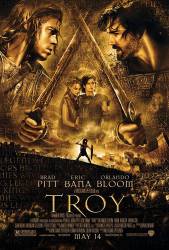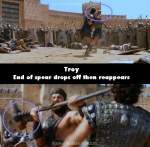Factual error: When the Trojans flee inside the walls at the arrival of the Greeks, you can see some llamas. Llamas were only known in Latin America and not in ancient Troy. (02:20:10)
Factual error: More than once the sun is seen rising over the sea. But that would be impossible, since the sun rises in the east and the sea around Troy is in the north and west, not in the east.
Factual error: When King Priam is showing Paris the Sword of Troy we get a close-up view of the blade and it looks suspiciously like steel or polished iron, as do a lot of the weapons which we see in this film. However, at the time of the Trojan War, civilization was still very much rooted in the Bronze Age and iron weapons would not have been available. Iron weapons were first used by the Philistines around 1100 BC, some years after the Trojan War, and it was still another several hundred years before this technology was ever used. (00:59:45)
Factual error: Probably the most common mistake in all the ancient warfare movies like Troy. The thick leather armour that soldiers wear is almost impossible to pierce with such crudely sharpened swords but they always seem to pierce the armour with effortless ease.
Factual error: The boy who is sent to retrieve Achilles, refers to Boagrius as the Thessalonian, speaking of those from Thessaly. Thessalonians are people from the Greek city of Thessalonika - which is settled about 1000 years AFTER the battle of Troy. People from Thessaly were/are called Thessalians. The term Thessalonian should never even have been known to the boy, much less used by him. (00:06:10)
Factual error: At least one riding pad includes a pair of visible stirrups - not invented until sometime in the fourth century A.D.
Factual error: Mycenae was located far inland, instead Tiryns was at that time a coast citadel city much like Mycenae. Thus the fleet of Agamemnon would have departed from there. Also Sparta never had a port.
Factual error: Most equipment used by the Greeks, such as the large round shields and Achilles helmet, is from the Classical Period (5-4th centuries BC). At the time when the epic is set, the Greeks used small bowl-shaped helmets and light leather shields shaped like the number 8.
Factual error: When we see Agamemnon on his throne at Mycenae, there are ships virtually outside the door. Whilst the sea at Argos is just visible from the hill of Mycenae, the citadel is several miles inland.
Factual error: When the Greek leaders are lining up to offer gifts to Agamemnon, one of them is carrying a red-figure vase shaped like a submarine. Red-figure pottery (made of red clay with a black glaze, from which lines and shapes are removed to make red images) was not made until the fifth century BC.







Answer: He doesn't yell any words, just an expression of anguish over his brothers death.